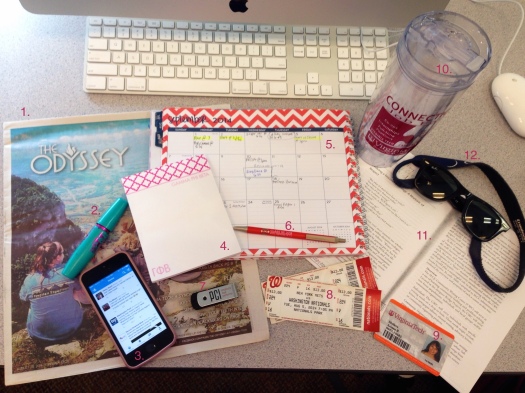The Exercise
Upon looking through my backpack and purse, I found the following multimodal texts:
1. Hokie Passport
Modes Included: Linguistic,Visual, Spatial, and Gestural
2. Five Star folder
Modes Included: Linguistic, Visual, and Spatial 3. Planner
Modes Included: Linguistic, Visual, and Spacial
4. Name tag craft I made for a class
Modes Included: Linguistic, Visual, and Spacial
5. Dell laptop charger
Modes Included: Linguistic, Visual, and Spatial
6. The North Face backpack logo and backpack type print
Modes Included: Linguistic, Visual, and Spatial
7. Printed DARS reports for professional writing and public relations
Modes Included: Linguistic, Visual, and Spatial
8. Printed course syllabus for this class
Modes Included: Linguistic, Visual, and Spatial
9. NFL Fantasy Football app on smartphone
Modes Included: Linguistic, Visual, Spatial, Aural, and Gestural
10. Digital camera
Modes Included: Linguistic, Visual, Spatial, and aural.
11. Fossil wallet logo
Modes Included: Linguistic, Visual, and Spatial
12. Union First Market Bank check card
Modes Included: Linguistic, Visual, and Spatial
Reflection
When performing this exercise, I noticed that most of the multimodal texts I found contain simply the linguistic, visual, and spatial modes of communication. This is because most of my texts, although recently made or printed, were formatted for the traditional medium of print. For instance, the text found on my laptop charger, five star folder, and planner was all formatted and designed for a flat surface.
However, I did find one multimodal text that contains all five modes of communication– the NFL Fantasy Football app I have on my smartphone. This app makes noises, shows visual images of people making gestures, and has linguistic texts, all of which is organized through the spatial mode.
In short, this exercise taught me that texts designed for new media often contain closer to all five modes of communication, while texts deigned for traditional media often contain simply the linguistic, spatial, and visual modes.





